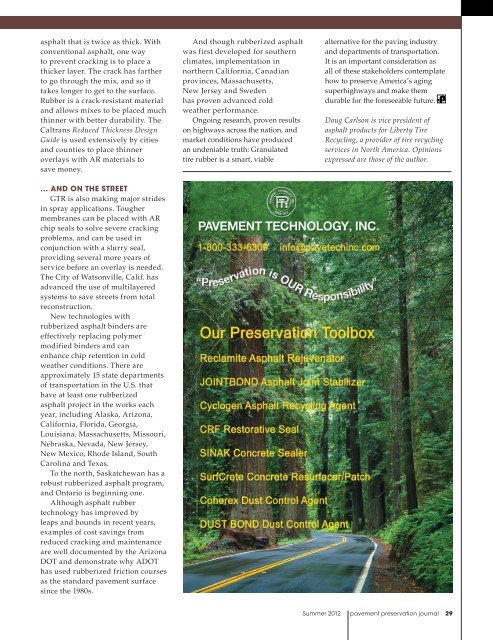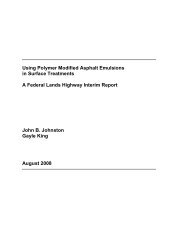journal - TSP2
journal - TSP2
journal - TSP2
You also want an ePaper? Increase the reach of your titles
YUMPU automatically turns print PDFs into web optimized ePapers that Google loves.
asphalt that is twice as thick. With<br />
conventional asphalt, one way<br />
to prevent cracking is to place a<br />
thicker layer. The crack has farther<br />
to go through the mix, and so it<br />
takes longer to get to the surface.<br />
Rubber is a crack-resistant material<br />
and allows mixes to be placed much<br />
thinner with better durability. The<br />
Caltrans Reduced Thickness Design<br />
Guide is used extensively by cities<br />
and counties to place thinner<br />
overlays with AR materials to<br />
save money.<br />
And though rubberized asphalt<br />
was first developed for southern<br />
climates, implementation in<br />
northern California, Canadian<br />
provinces, Massachusetts,<br />
New Jersey and Sweden<br />
has proven advanced cold<br />
weather performance.<br />
Ongoing research, proven results<br />
on highways across the nation, and<br />
market conditions have produced<br />
an undeniable truth: Granulated<br />
tire rubber is a smart, viable<br />
alternative for the paving industry<br />
and departments of transportation.<br />
It is an important consideration as<br />
all of these stakeholders contemplate<br />
how to preserve America’s aging<br />
superhighways and make them<br />
durable for the foreseeable future.<br />
Doug Carlson is vice president of<br />
asphalt products for Liberty Tire<br />
Recycling, a provider of tire recycling<br />
services in North America. Opinions<br />
expressed are those of the author.<br />
... AND ON THE STREET<br />
GTR is also making major strides<br />
in spray applications. Tougher<br />
membranes can be placed with AR<br />
chip seals to solve severe cracking<br />
problems, and can be used in<br />
conjunction with a slurry seal,<br />
providing several more years of<br />
service before an overlay is needed.<br />
The City of Watsonville, Calif. has<br />
advanced the use of multilayered<br />
systems to save streets from total<br />
reconstruction.<br />
New technologies with<br />
rubberized asphalt binders are<br />
effectively replacing polymer<br />
modified binders and can<br />
enhance chip retention in cold<br />
weather conditions. There are<br />
approximately 15 state departments<br />
of transportation in the U.S. that<br />
have at least one rubberized<br />
asphalt project in the works each<br />
year, including Alaska, Arizona,<br />
California, Florida, Georgia,<br />
Louisiana, Massachusetts, Missouri,<br />
Nebraska, Nevada, New Jersey,<br />
New Mexico, Rhode Island, South<br />
Carolina and Texas.<br />
To the north, Saskatchewan has a<br />
robust rubberized asphalt program,<br />
and Ontario is beginning one.<br />
Although asphalt rubber<br />
technology has improved by<br />
leaps and bounds in recent years,<br />
examples of cost savings from<br />
reduced cracking and maintenance<br />
are well documented by the Arizona<br />
DOT and demonstrate why ADOT<br />
has used rubberized friction courses<br />
as the standard pavement surface<br />
since the 1980s.<br />
384457_Pavement.indd 1<br />
Summer 2012 pavement preservation <strong>journal</strong> 5/28/08 8:36:54 29 AM
















